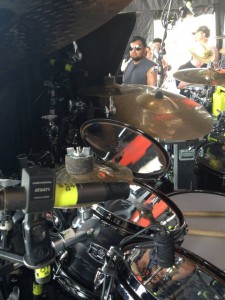 This is the first installment in guest blogger Steve Lagudi’s series on miking drums – today, he’ll begin discussing the art of miking live kits.
Metal and hard-rock is notorious for having huge drum sounds (as well as everything else). It is very common for most drummers to have pretty large drum kits that will require a lot of mics to capture their full sound. Obviously you will have to deal with a lot of bleed from all those mics, bashing drummers, screaming loud monitors and amps on stage – making it a joy to mic it all up. Now everyone thinks I am outta my mind when they see my input list. Every drum having its own mic, often times several mics. Then comes show time and they are floored at how I am able to take all that and get a huge, in your face, deep, clear drum sound. I get asked the same question each and every time: “How do you do it?”
First and foremost, the most important tool I use…[noise] gates. They are critical for me. It is possible without gates, but for me, it’s all about having gates. It is so important that I actually carry my gates with me. Smaller venues, and even larger ones, will not always have the gates you want, or enough channels of gates. I see it all the time – no gates, or just 2 or 4 channel gates, and then they don’t have the proper controls to really dial in the gates properly…so I just bring my own. Using condenser mics on almost all of the drums, it can be very tricky since condenser mics will introduce not only all the little details, but will introduce a lot more bleed too. The gates help clean up all that bleed, that’s the whole purpose of them.
I get a little creative with it, though…not that I am reinventing the wheel, but I like tight gates to get that attack and punch, quickly. For sustain, I rely on reverb, usually two, the first a room sound, the second a plate. The room helps create and put the drums in a nice space and the plate is used to give extra decay since the gate is cutting most of the sustain off.
In Steve’s next installment, he’ll start breaking down the drum set and discuss miking each component individually – first up, kicks! Look for it next Wednesday! For more background on Steve Lagudi, check out his Bio here.
This is the first installment in guest blogger Steve Lagudi’s series on miking drums – today, he’ll begin discussing the art of miking live kits.
Metal and hard-rock is notorious for having huge drum sounds (as well as everything else). It is very common for most drummers to have pretty large drum kits that will require a lot of mics to capture their full sound. Obviously you will have to deal with a lot of bleed from all those mics, bashing drummers, screaming loud monitors and amps on stage – making it a joy to mic it all up. Now everyone thinks I am outta my mind when they see my input list. Every drum having its own mic, often times several mics. Then comes show time and they are floored at how I am able to take all that and get a huge, in your face, deep, clear drum sound. I get asked the same question each and every time: “How do you do it?”
First and foremost, the most important tool I use…[noise] gates. They are critical for me. It is possible without gates, but for me, it’s all about having gates. It is so important that I actually carry my gates with me. Smaller venues, and even larger ones, will not always have the gates you want, or enough channels of gates. I see it all the time – no gates, or just 2 or 4 channel gates, and then they don’t have the proper controls to really dial in the gates properly…so I just bring my own. Using condenser mics on almost all of the drums, it can be very tricky since condenser mics will introduce not only all the little details, but will introduce a lot more bleed too. The gates help clean up all that bleed, that’s the whole purpose of them.
I get a little creative with it, though…not that I am reinventing the wheel, but I like tight gates to get that attack and punch, quickly. For sustain, I rely on reverb, usually two, the first a room sound, the second a plate. The room helps create and put the drums in a nice space and the plate is used to give extra decay since the gate is cutting most of the sustain off.
In Steve’s next installment, he’ll start breaking down the drum set and discuss miking each component individually – first up, kicks! Look for it next Wednesday! For more background on Steve Lagudi, check out his Bio here.
Published
22nd January 2014